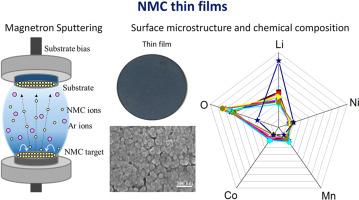沉积压力驱动下LiNixMnyCozO2薄膜组成、结构、光学和电化学性能的演变
IF 3.9
2区 材料科学
Q2 MATERIALS SCIENCE, MULTIDISCIPLINARY
引用次数: 0
摘要
高性能LiNixMnyCozO2 (NMC)薄膜阴极用于先进的锂离子微电池的开发需要精确控制沉积条件,以优化结构和电化学性能。本研究研究了射频磁控溅射过程中氩气工作压力(4、8、12、16和20 mTorr)对NMC薄膜物理化学特性的影响,重点研究了残余气体污染的潜在影响。结构分析表明,中间压力(8 mTorr)提高了结晶度,减小了晶格间距(4.68 Å),并诱导了压应力(−0.811 GPa)。扫描电镜显示了压力依赖性的形态演变,较高的压力(20 mTorr)产生更薄的薄膜(66.6 nm)和更细的颗粒(21.4 nm),这是由于吸附原子迁移率降低。XPS强调了元素调制,显示在高压下锂耗尽(32.57 - 18.04%),同时增加了Mn2+/Mn3+和Co2+/Co3+氧化态,表明氧空位的产生。光学带隙缩小(3.22-2.91 eV)与压力突出缺陷引起的电子修饰。电化学测试表明,8 mTorr薄膜的初始放电容量为65.21 mAh/g,但容量衰减迅速(60次循环后保持9.29%),并伴有电荷转移阻力(Rct = 779.30 Ω)和微观结构退化。这些发现可以作为概念验证数据,突出了溅射压力对薄膜性能的影响,并指导未来集成微电池开发的优化。本文章由计算机程序翻译,如有差异,请以英文原文为准。

Deposition pressure-driven evolution of composition, structure, optical, and electrochemical properties in LiNixMnyCozO2 thin films
The development of high-performance LiNixMnyCozO2 (NMC) thin-film cathodes for advanced lithium-ion micro-batteries requires precise control over deposition conditions to optimize structural and electrochemical properties. This study investigates the influence of Ar working pressure (4, 8, 12, 16, and 20 mTorr) during RF magnetron sputtering on the physicochemical characteristics of NMC thin-film, focusing on potential effects from residual gas contamination. Structural analysis reveals that intermediate pressures (8 mTorr) enhance crystallinity, reduce lattice spacing (4.68 Å), and induce compressive stress (−0.811 GPa). SEM demonstrated pressure-dependent morphological evolution, with higher pressures (20 mTorr) yielding thinner films (66.6 nm) and finer grains (21.4 nm) due to reduced adatom mobility. XPS highlighted elemental modulation, showing lithium depletion (32.57–18.04 %) at elevated pressures, alongside increased Mn2+/Mn3+ and Co2+/Co3+ oxidation states, indicative of oxygen vacancy generation. Optical bandgap narrowing (3.22–2.91 eV) with pressure highlights defect-induced electronic modifications. Electrochemical testing of the 8 mTorr film reveals an initial discharge capacity of 65.21 mAh/g, but with rapid capacity fade (9.29 % retention after 60 cycles), accompanied by charge transfer resistance (Rct = 779.30 Ω) and microstructural degradation. These findings serve as proof-of-concept data, highlighting the influence of sputtering pressure on film properties and guiding future optimization for integrated microbattery development.
求助全文
通过发布文献求助,成功后即可免费获取论文全文。
去求助
来源期刊

Vacuum
工程技术-材料科学:综合
CiteScore
6.80
自引率
17.50%
发文量
0
审稿时长
34 days
期刊介绍:
Vacuum is an international rapid publications journal with a focus on short communication. All papers are peer-reviewed, with the review process for short communication geared towards very fast turnaround times. The journal also published full research papers, thematic issues and selected papers from leading conferences.
A report in Vacuum should represent a major advance in an area that involves a controlled environment at pressures of one atmosphere or below.
The scope of the journal includes:
1. Vacuum; original developments in vacuum pumping and instrumentation, vacuum measurement, vacuum gas dynamics, gas-surface interactions, surface treatment for UHV applications and low outgassing, vacuum melting, sintering, and vacuum metrology. Technology and solutions for large-scale facilities (e.g., particle accelerators and fusion devices). New instrumentation ( e.g., detectors and electron microscopes).
2. Plasma science; advances in PVD, CVD, plasma-assisted CVD, ion sources, deposition processes and analysis.
3. Surface science; surface engineering, surface chemistry, surface analysis, crystal growth, ion-surface interactions and etching, nanometer-scale processing, surface modification.
4. Materials science; novel functional or structural materials. Metals, ceramics, and polymers. Experiments, simulations, and modelling for understanding structure-property relationships. Thin films and coatings. Nanostructures and ion implantation.
 求助内容:
求助内容: 应助结果提醒方式:
应助结果提醒方式:


